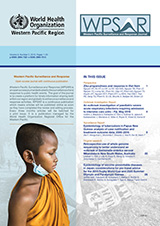Epidemiology of tuberculosis in Papua New Guinea: analysis of case notification and treatment-outcome data, 2008–2016
DOI:
https://doi.org/10.5365/wpsar.2018.9.1.006Abstract
Papua New Guinea has strengthened its surveillance system for tuberculosis (TB) under the National TB Program. This paper provides an overview of TB surveillance data at the national and subnational levels from 2008 to 2016.
TB case notification has consistently increased since 2008 with 6184 cases (93 per 100 000 population) in 2008 to 28 598 (359 per 100 000 population) in 2014 and has stabilized since 2014 with 28 244 cases (333 per 100 000 population) in 2016. The population-screening rate for TB rose from 0.1% in 2008 to 0.4% in 2016. Notified cases were dominated by extra-pulmonary TB (EP-TB, 42.4% of all cases in 2016). The proportion of pulmonary TB cases with no sputum test results was high with a national average of 26.6%. The regional variation of case notifications was significant: the Southern Region had the highest number and rate of notified TB cases. Of the nationally reported cases, 26.7% occurred in children. Treatment success rates remained low at 73% for bacteriologically confirmed TB and 64% for all forms of TB in 2016, far below the global target of 90%. For all forms of TB, 19% of patients were lost to follow-up from treatment.
An analysis of TB data from the national surveillance system has highlighted critical areas for improvement. A low population-screening rate, a high proportion of pulmonary TB cases without sputum test results and a low treatment success rate suggest areas for improvement in the National TB Program. Our additional subnational analysis helps identify geographical and programmatic areas that need strengthening and should be further promoted to guide the programme’s direction in Papua New Guinea.
References
Global TB Report 2017. Geneva, World Health Organization, 2017. (http://www.who.int/tb/publications/global_report/en/, accessed on 12 February 2018)
A review of health leadership and management capacity in Papua New Guinea- Human Resources for Health Hub 2011.
(www.hrhhub.unsw.edu.au , accessed on 13 February 2018).
Definitions and reporting framework for tuberculosis–2013 revision (updated December 2014). Geneva, World Health Organization, 2014. (http://apps.who.int/iris/bitstream/10665/79199/1/9789241505345_eng.pdf, accessed on 31 December 2017).
Morishita F, Burrus-Furphy V, Kobayashi M, Nishikiori N, Eang MT, Yadav R-P. Tuberculosis case-finding in Cambodia: analysis of case notification data, 2000 to 2013. West Pacific Surveill Response J. 2014;6(1):1–10.
National Strategic Plan for Tuberculosis in Papua New Guinea (2015-2020).Government of , Papua New Guinea, October 2014.
Chang E, Luelmo F, Baydulloeva Z, Joncevska M, Kasymova G, Bobokhojaev O, Mohr T. External Quality Assessment of Sputum Smear Microscopy in tuberculosis Laboratories in Sughd, Tajikistan. Cent Asian J Glob Health. 2016 Mar 4;4(2):230. doi: 10.5195/cajgh.2015.230. pmid:29138725
Hiatt T, Nishikiori N. Epidemiology and control of tuberculosis in the Western Pacific Region: update with 2013 case notification data. Western Pacific Surveillance and Response Journal, 2016 May 2;7(2):41-50. doi: 10.5365/WPSAR.2015.6.4.010. pmid:27508090
Chaimowicz F. Age transition of tuberculosis incidence and mortality in Brazil. Rev saúde pública. 2001;35(1):81–7.
Global TB database. Geneva, World Health Organization. (http://www.who.int/tb/country/data/download/en/, accessed on 12 February 2018).
Shingadia D, Novelli V. Diagnosis and treatment of tuberculosis in children. Lancet Infect Dis. 2003/10/03. 2003;3(10):624–32.
Dodd PJ, Gardiner E, Coghlan R, Seddon JA. Burden of childhood tuberculosis in 22 high-burden countries: A mathematical modelling study. Lancet Glob Heal. 2014;2(8):e453–9.
Joint External Review of the National Tuberculosis Programme of Papua New Guinea, February 2014.
Kauntim Mi Tu (IBBS), Port Moresby, 2017
The Sixty-Seventh World Health Assembly. Global strategy and targets for tuberculosis prevention, care and control after 2015. Geneva; World Health Organization, May 21, 2014. (http://apps.who.int/gb/ebwha/pdf_files/WHA67-REC1/A67_2014_REC1-en.pdf, accessed on 13 February 2018).
Diefenbach-Elstob T, Plummer D, Dowi R, Wamagi S, Gula B, Siwaeya K, et al. The social determinants of tuberculosis treatment adherence in a remote region of Papua New Guinea. BMC Public Health. 2017;17(1):1–12.
Nishikiori N, Morishita F. Using tuberculosis surveillance data for informed programmatic decision-making. West Pacific Surveill Response J. 2013;4(1):1–3.

